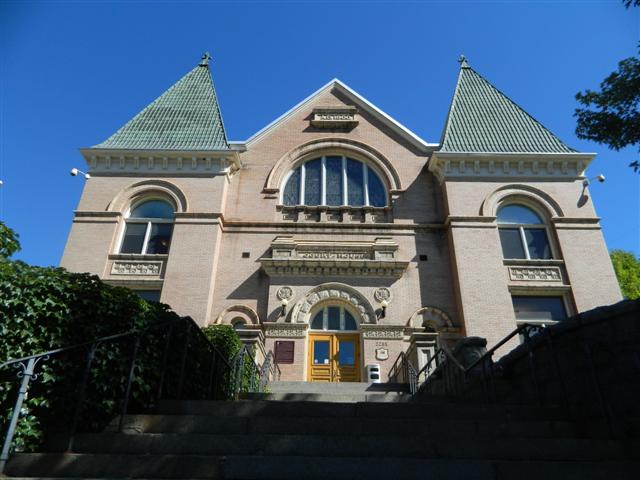TALES AND LEGENDS OF THE MOUNTAIN KINGDOM: Two architects
Bookending three blocks of downtown Rossland, two massive brick and stone buildings, the courthouse and the edifice that once housed the Bank of Montreal, stand like sentinels on Columbia Avenue, having survived over a hundred years of drama, history, and devastating fires.
The courthouse, on higher ground, commands a grand view of the Mountain Kingdom and its surrounding landscape. With three sharp, pyramidal peaked roofs ornamented with finials, and other architectural features such as a cupola, four tower sections, and gabled parapets, this dramatic building is one of Rossland’s iconic landmarks. Built between 1898 and 1901, it’s constructed from buff brick on the upper floors, and has a basement made from cut rubble stone.
The basement used to be Rossland’s prison, but if you were a young-ish whippersnapper back in the 1970s and early 80s, you would have known that basement as the public library, where I distinctly remember going on a regular basis to check out Curious George books. To this day, I associate Curious George with that basement library, in the fondest of ways (which is more than I can say for most basements I’ve had experiences with during my life which were mostly dank, spidery messes).
The courthouse’s architect was a man named John J. Honeyman, who hailed from Glasgow and was born in 1864. He was the nephew of a well-known Scottish architect of the Victorian period. Honeyman studied architecture in Heidelburg, Germany and did his apprenticing in Glasgow. In 1889 he emigrated to Canada and took the train across the country, eventually winding up on Vancouver Island, where he married a fellow Scottish immigrant, and set up his own architecture firm. He designed several buildings in Nanaimo before relocating to Rossland in 1897.
Though construction of the courthouse started in 1898, there were issues with contractors during the building process, and, as is typical, the budget began to get out of control, ballooning from $38,500 to $58,122. The end product, however, was spectacular. The stained glass was created by Henry Bloomfield & Sons, and the interior is described as having a “symmetrical floor plan, notably second floor configuration containing main courtroom, judges chambers, barristers room, law library, sheriff’s office and smaller courtroom…including original fixtures [such as] stained glass windows, wall and ceiling panelling, timber beamed ceiling with inlaid cedar panels…[and] a central hall with imposing main staircase with ornate newel posts and railings.” Rossland’s courthouse became an official heritage building in 1980, the same year I remember going there for my father’s citizenship ceremony.
It’s worth noting that Honeyman also did residential work around Rossland, and one of his enduring buildings now houses the Black Bear Bed and Breakfast in lower Rossland at 1375 Spokane St., which was built in 1900.
It was in Rossland that Honeyman met his future partner, George Curtis, whose work you can see all over Nelson, including the courthouse there. Eventually, both architects moved to Vancouver and started the firm of Honeyman & Curtis, and they were jointly responsible for a whole slew of buildings, including the Bank of Montreal building at the corner of Main & Hastings, located in the now-infamous DTES. They also designed the Kamlooops and Fernie courthouses. Incidentally, Curtis, before he partnered with Honeyman, designed the Greenwood courthouse. That’s a lot of courthouses between the two.
Another joint project the two took on was the overseeing of the building of the original portion of the Empress Hotel in Victoria. That was designed by Francis Rattenbury, but he resigned from the project in 1906.
And speaking of Francis Rattenbury, he has a Rossland connection, too, being the architect who designed Columbia Avenue’s other landmark building, the former Bank of Montreal.
Born in Leeds, England in 1867, he came to Canada in 1892 and very shortly thereafter entered a contest that sought out designs for the new legislative buildings in Victoria. Rattenbury entered under a pseudonym, “A B.C. Architect”, and won the contest. Built in “British High Victorian Gothic, mid-nineteenth century Italianate and American Richardsonian Romanesque styles”, the construction of the masterpiece was $400,000 over budget by its completion in 1898. Rattenbury was also responsible for courthouses in Chilliwack and Nanaimo, Banks of Montreal in New Westminster and Nelson, and the long-ago demolished Rossland Hotel.
Construction of Rossland’s Bank of Montreal began in 1898 and was completed two years later. It had more to it than the spectacular Victorian plasterwork ceiling in the bank proper’s space: it had residential space on its second floor for staff and an apartment for the bank manager complete with a parquet-floored living room.
I’ve loved this building from childhood; I loved the tall windows, I loved the plaster worked ceilings, I loved the sense of history this building had about it. It was where I had my first ever bank account, and as a child, it was where I got my hair cut – where all of us in the family got our hair cuts – when the front rooms of the basement houses Classic Kuts and Lee’s barber shop (now Red Pair Shoes). I am thrilled to bits that this gorgeous old building is now enjoying a renaissance after being deserted and derelict for many years after the bank closed.
According to sources, Francis Rattenbury had a terrible reputation personality-wise. He was described as being “ill-tempered” and extremely cheap. Though he was a fantastic architect, he had his share of personal issues. In 1923, he went through a divorce and took up with a younger woman named Alma, but their relationship began to disintegrate as Rattenbury’s financial situation began to deteriorate. Eventually, Alma had an affair with her husband’s 18 year old chauffeur, George Stoner, and together they conspired to kill Rattenbury.
In 1935, Rattenbury was found dead in his sitting room, bludgeoned to death by a carpenter’s hammer. Alma originally confessed, but later retracted her confession, and then Stoner confessed that he had actually done the deed. He was sentenced to death, but eventually had his sentenced reduced to a life sentence, but he was released after seven years so he could join the army for the Second World War. Alma, who went to trial for being an accessory after the fact, committed suicide by drowning herself in a river in Dorset after being acquitted for her part in the crime.
Another Rossland-related character’s life ended in a bizarre tragedy…
Honeyman retired 1931 and died at home in Vancouver on February 18, 1934.
Their legacies to Rossland endure and should continue to do so for decades to come.
Sources:
http://www.historicplaces.ca/en/rep-reg/place-lieu.aspx?id=7838
http://www.michaelkluckner.com/bciw3greenwood.html
http://en.wikipedia.org/wiki/Francis_Rattenbury
http://www.canadaka.net/modules.php?name=Famous_Canadians&action=viewperson&person=404
http://www.crowsnest-highway.ca/
























